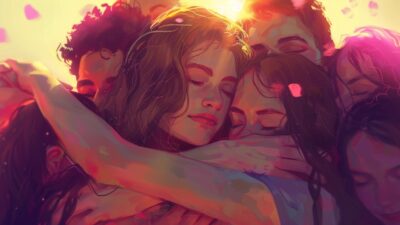Poetry is a form of art that uses language to create beauty, evoke emotion, and tell stories. There are many different types of poems, each with its own unique characteristics. In this article, we will explore several different types of poems.
What Are The Different Types Of Poems?

There are probably hundreds of different types of poems and variations. Here’s a big list of the most popular types of poems.
- Acrostic (A-Z) A poem in which the first letter of each line spells out a word or phrase. Acrostic poems are often used as gifts or messages.
- Sonnet (14 lines) (iambic pentameter) (abab cdcd efef gg) A 14-line poem with a specific rhyme scheme and meter. Sonnets often explore themes of love, loss, or beauty.
- Epic (Long) (heroic couplets) A long poem that tells a story of heroic deeds. Epics often feature gods, monsters, and other supernatural elements.
- Haiku (5 syllables) (7 syllables) (5 syllables) A Japanese poem with three lines of 5, 7, and 5 syllables. Haiku often focus on nature and the natural world.
- Free Verse No meter or rhyme scheme A poem that does not follow any specific meter or rhyme scheme. Free verse poems are often more experimental and allow the poet more freedom of expression.
- Limerick (5 lines) (aabba) A short, humorous poem with five lines and a specific rhyme scheme. Limericks often have a silly or nonsensical ending. Limericks are often popular wriring structures for Irish jokes.
- Limerick with Refrain (5 lines) (aabba) (Refrain) A limerick that repeats the same line at the end of the poem. Limericks with refrains often have a silly or nonsensical ending.
- Ballad (Four-line stanzas) A poem that tells a story in a simple, straightforward way. Ballads often have a repetitive refrain.
- Villanelle (19 lines) (abab abab cdcdcd ee) A poem with 19 lines and a specific rhyme scheme. Villanelles often explore themes of love, loss, or regret.
- Ode (No set form) A poem that celebrates a person, place, or thing. Odes often use formal language and a serious tone.
- Ghazal (Couplets) A poem of Persian origin with a specific rhyme scheme and meter. Ghazals often explore themes of love, loss, or longing.
- Blank Verse (Iambic pentameter) A poem that is written in iambic pentameter but does not rhyme. Blank verse is often used for serious or dramatic poems.
- Cinquain (5 lines) (2-2-3-2-1 syllables) A five-line poem with a specific syllable count and rhyme scheme. Cinquains are often used to express a single thought or idea.
- Epigram (Short) (witty) A short, witty poem that makes a sharp or pointed observation. Epigrams are often used to satirize or criticize.
- Pantoum (Quatrains) A poem that repeats the second and fourth lines of each quatrain in the next quatrain. Pantoums are often used to explore complex or contradictory ideas.
- Rondeau (15 lines) A poem with a specific rhyme scheme and meter. Rondeaus often have a playful or ironic tone.
- Sestina (6 stanzas) (3 lines) A poem with six stanzas, each of which contains three lines. Sestinas often explore themes of loss, memory, or regret.
- Villanelle with Refrain (19 lines) (abab abab cddc dcdde) A villanelle with a refrain is a villanelle that repeats the same line at the end of each stanza. Villanelles with refrains often explore themes of love, loss, or obsession.
- Triolet (8 lines) (aabb aabb aa) A poem with eight lines and a specific rhyme scheme. Triolets often have a playful or ironic tone.
- Tanka (5 lines) (5-7-5-7-7 syllables) A Japanese poem with five lines of 5, 7, 5, 7, and 7 syllables. Tanka often focus on nature and the natural world.
- Clerihew (4 lines) A short, humorous poem that introduces a person or character in the first line and then provides a witty or satirical description of them in the next three lines.
- Eclogue (Pastoral) A poem that describes rural life and the natural world. Eclogues often feature shepherds and other rural characters.
- Elegy (Absence) A poem that mourns the death of a person or thing. Elegies often express grief, loss, or regret.
- Epithalamion (Wedding) A poem that celebrates a wedding. Epithalamia often express happiness, joy, and hope.
- Free-form (No set form) A poem that does not follow any specific form or rhyme scheme. Free-form poems are often more experimental and allow the poet more freedom of expression.
- Lyric (Personal) A poem that expresses the poet’s own thoughts, feelings, and experiences. Lyrics often have a musical quality and are meant to be read aloud.
- Ottava Rima (Eight-line stanzas) A poem that is written in eight-line stanzas with a specific rhyme scheme. Ottava rima is often used for satirical or narrative poems.
- Pantoum with Refrain (Quatrains) A poem that repeats the second and fourth lines of each quatrain in the next quatrain, and also repeats the same line at the end of each stanza. Pantoums with refrains often explore complex or contradictory ideas.
- Rondeau with Refrain (15 lines) A poem with a specific rhyme scheme and meter, and also repeats the same line at the end of each stanza. Rondeaus with refrains often have a playful or ironic tone.
- Sonnet Sequence (A series of sonnets) A series of sonnets that are linked together by a common theme or subject. Sonnet sequences often explore love, loss, or the passage of time.
- Villanelle with Refrain (19 lines) (abab abab cddc dcdde) A Villanelle with a refrain is a Villanelle that repeats the same line at the end of each stanza, and also repeats the same line at the end of the poem. Villanelles with refrains often explore themes of love, loss, or obsession.
- Aubade (Morning) A poem that is set in the early morning hours and often reflects on the passage of time or the impermanence of life.
- Ballade (3 stanzas) (Refrain) A poem with three stanzas, each of which ends with a refrain. Ballades often have a narrative or romantic theme.
- Catalectic (Missing syllables) A poem that has missing syllables at the end of lines. Catalectic poems often have a playful or ironic tone.
- Chanson (French) A poem of French origin that is often set to music. Chansons often have a romantic or lyrical theme.
- Dactylic (Dactyls) A poem that is written in dactylic meter, which is a meter that is based on dactyls, a metrical foot that consists of one long syllable followed by two short syllables.
- Enjambment (Run-on lines) A poem that has lines that run on to the next line without a break. Enjambment often creates a sense of momentum or flow in a poem.
- Nocturne (Night) A poem that is set at night and often reflects on the darkness, silence, or mystery of the night.
- Ode with Refrain (No set form) (Refrain) An ode that repeats the same line at the end of the poem. Odes with refrains often explore themes of love, loss, or beauty.
- Sestina with Refrain (6 stanzas) (3 lines) (Refrain) A sestina that repeats the same line at the end of each stanza. Sestinas with refrains often explore themes of loss, memory, or regret.
- Blank Verse Sonnet (14 lines) (iambic pentameter) (abab cdcd efef gg) A 14-line poem with a specific rhyme scheme and meter, written in iambic pentameter. Blank verse sonnets often explore themes of love, loss, or beauty.
- Clerihew with Refrain (4 lines) (humorous) (Refrain) A short, humorous poem that introduces a person or character in the first line and then provides a witty or satirical description of them in the next three lines. The poem repeats the same line at the end.
- Concrete Poem (A poem that uses the physical shape of the poem to create meaning) A poem that uses the physical shape of the poem to create meaning. Concrete poems are often visual and can be read in different ways.
- Copla (Spanish) (8-line stanza) (Specific rhyme scheme) A Spanish poem with eight lines and a specific rhyme scheme. Coplas often have a romantic or lyrical theme.
- Couplet (2 lines) (Rhymed) A poem with two lines that rhyme. Couplets are often used to create a sense of rhythm or balance in a poem.
- Dactylic (Dactyls) (Meter based on dactyls) A poem that is written in dactylic meter, which is a meter that is based on dactyls, a metrical foot that consists of one long syllable followed by two short syllables.
- Eclogue with Refrain (Pastoral) (Refrain) A poem that describes rural life and the natural world. The poem repeats the same line at the end.
- Elegy with Refrain (Absence) (Refrain) A poem that mourns the death of a person or thing. The poem repeats the same line at the end.
- Epigram with Refrain (Short) (Witty) (Refrain) A short, witty poem that makes a sharp or pointed observation. The poem repeats the same line at the end.
- Epithalamion with Refrain (Wedding) (Refrain) A poem that celebrates a wedding. The poem repeats the same line at the end.
Different Poem Types
This is just a small sampling of the many different types of poems that exist. There are many other types of poems, each with its own unique form and style. If we missed any of your favorite types of poems, please let us know in the comments.
I’m a dog owner that loves poetry, vampires, mountain biking, and cosplay. I’m open to ideas and still trying to figure my SFO life out one blog post at a time. LF ISO SWF GSOH SI DDF.















 The 6 Best Goonies Sloth Quotes
The 6 Best Goonies Sloth Quotes
Leave a Reply
You must be logged in to post a comment.